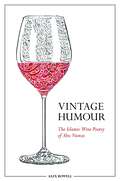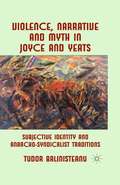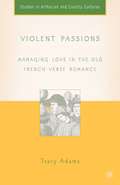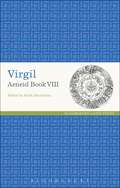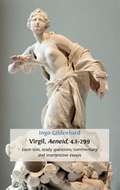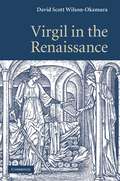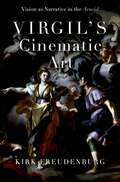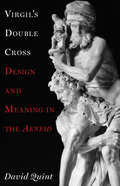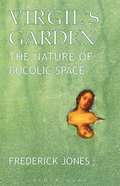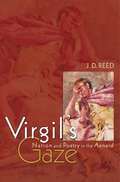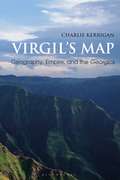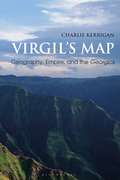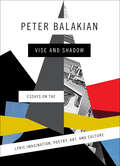- Table View
- List View
The View We're Granted (Johns Hopkins: Poetry and Fiction)
by Peter FilkinsIn the pivotal poem "Marking Time," which appears almost exactly halfway through Peter Filkins’s fourth collection of poetry, the speaker reflects on the death of a sibling and how time is marked by our memories. These memories, these moments—whether spent contemplating a painting by Vermeer or the simple toss of a bean bag—ultimately shape who we are. "Yet you are with me here, with me here again, / where neither that moon nor you exist, but live / tethered to this memory composed of words." These are poems unafraid to be graceful and engaging. They attain an assurance and stability rare in contemporary poetry, while their careful balance of sadness and joy reminds the reader of the difficult negotiations we make in life.
The View We're Granted (Johns Hopkins: Poetry and Fiction)
by Peter FilkinsIn the pivotal poem "Marking Time," which appears almost exactly halfway through Peter Filkins’s fourth collection of poetry, the speaker reflects on the death of a sibling and how time is marked by our memories. These memories, these moments—whether spent contemplating a painting by Vermeer or the simple toss of a bean bag—ultimately shape who we are. "Yet you are with me here, with me here again, / where neither that moon nor you exist, but live / tethered to this memory composed of words." These are poems unafraid to be graceful and engaging. They attain an assurance and stability rare in contemporary poetry, while their careful balance of sadness and joy reminds the reader of the difficult negotiations we make in life.
Vintage Humour: The Islamic Wine Poetry of Abu Nuwas
by Alex RowellAbu Nuwas, the pre-eminent bacchic bard of the classical Arabic canon, was loved and reviled in equal measure for his lyrical celebration of Abbasid Baghdad's dissolute nightlife, his cutting satires of religion and the clergy, and the extraordinary range and virtuosity of his literary talent. Vintage Humour contains approximately 120 translations, each replicating the monorhyme scheme of the originals, with commentary where appropriate, a brief history of the poet's life and times, and a glossary of the key themes, motifs, and running jokes of the poems themselves. Based on extensive research with both Arabic and English source materials, Vintage Humour is an illuminating collection, of interest to both general and informed readers with an interest in Islamic studies, Arabic literature, and the history of Iraq and the Middle East.
Vintage Humour: The Islamic Wine Poetry of Abu Nuwas
by Alex RowellAbu Nuwas, the pre-eminent bacchic bard of the classical Arabic canon, was loved and reviled in equal measure for his lyrical celebration of Abbasid Baghdad's dissolute nightlife, his cutting satires of religion and the clergy, and the extraordinary range and virtuosity of his literary talent. Vintage Humour contains approximately 120 translations, each replicating the monorhyme scheme of the originals, with commentary where appropriate, a brief history of the poet's life and times, and a glossary of the key themes, motifs, and running jokes of the poems themselves. Based on extensive research with both Arabic and English source materials, Vintage Humour is an illuminating collection, of interest to both general and informed readers with an interest in Islamic studies, Arabic literature, and the history of Iraq and the Middle East.
Violence, Narrative and Myth in Joyce and Yeats: Subjective Identity and Anarcho-Syndicalist Traditions
by T. BalinisteanuHow can we use art to reconstruct ourselves and the material world? Is every individual an art object? Is the material world an art text? This book answers these questions by examining modernist literature, especially James Joyce and W.B. Yeats, in the context of anarchist intellectual thought and Georges Sorel's theory of social myth.
Violence, Trauma, and Virtus in Shakespeare's Roman Poems and Plays: Transforming Ovid
by L. Starks-EstesEmploying psychoanalysis, trauma theory, and materialist perspectives, this book examines Shakespeare's appropriations of Ovid's poetry in his Roman poems and plays. It argues that Shakespeare uses Ovid to explore violence, trauma, and virtus - the traumatic effects of aggression, sadomasochism, and the shifting notions of selfhood and masculinity.
Violent Passions: Managing Love in the Old French Verse Romance (Arthurian and Courtly Cultures)
by T. AdamsThis book re-evaluates the perception of "courtly love" in Old French verse. Adams traces how these verses explore the emotional trials of amour and propose coping methods for the lovelorn.
Virgil (Understanding Classics)
by Alison KeithThe works of Virgil (70–19 BCE) define the 'golden age' of Latin poetry and have inspired a long tradition of interpretation and adaptation that starts in his own time and extends to important modern authors. His ascent from the lesser genre of pastoral (the Bucolics) through a more ambitious didactic mode (the Georgics) to the soaring heights of epic (the incomparable Aeneid) shaped the canonical writings of other authors, from his younger contemporary Ovid through the medieval writers Dante and Petrarch to the early modern poets Spenser and Milton and well beyond. Virgil, as Alison Keith shows, has never gone out of critical or popular fashion. This wide-ranging introduction appraises a figure of central importance in the history of Western music, art and literature. Offering close readings of the Bucolics, Georgics and Aeneid, Keith places Virgil and his poetry in historical context before tracing their impact at key moments in the culture of the West. Emphasis is placed on Virgil's reception of the classical literary and philosophical traditions, and on how his poetry has attracted modern interest from writers as diverse as T. S. Eliot and Ursula K. Le Guin.
Virgil (Understanding Classics #1)
by Alison KeithThe works of Virgil (70–19 BCE) define the 'golden age' of Latin poetry and have inspired a long tradition of interpretation and adaptation that starts in his own time and extends to important modern authors. His ascent from the lesser genre of pastoral (the Bucolics) through a more ambitious didactic mode (the Georgics) to the soaring heights of epic (the incomparable Aeneid) shaped the canonical writings of other authors, from his younger contemporary Ovid through the medieval writers Dante and Petrarch to the early modern poets Spenser and Milton and well beyond. Virgil, as Alison Keith shows, has never gone out of critical or popular fashion. This wide-ranging introduction appraises a figure of central importance in the history of Western music, art and literature. Offering close readings of the Bucolics, Georgics and Aeneid, Keith places Virgil and his poetry in historical context before tracing their impact at key moments in the culture of the West. Emphasis is placed on Virgil's reception of the classical literary and philosophical traditions, and on how his poetry has attracted modern interest from writers as diverse as T. S. Eliot and Ursula K. Le Guin.
Virgil: Aeneid VIII (Latin Texts)
by Keith MaclennanBook VIII of the Aeneid presents a crucial turning point in the mythological foundation of Rome, with clear political resonances for the future Augustan regime. Set on the verge of war between the Latins and Aeneas' Trojan forces, it describes Aeneas' visit to the future site of Rome, where he enlists the help of the Arcadian King Evander for the forthcoming war.In confirmation of the gods' support for Aeneas, his mother Venus presents her son with new armour, including a shield depicting key events in the future history of Rome. Their climax is Augustus' victory at Actium over the forces of Mark Antony and Cleopatra. This new edition makes the Latin text accessible to students, with commentary notes providing ample linguistic help, explanation of difficult words and phrases, a glossary of grammatical and literary terminology, and a full list of vocabulary and proper names. The in-depth introduction sets the work in its literary and historical context, and provides an overview of Virgil's metrical and stylistic points.
Virgil: Aeneid VIII (Latin Texts)
by Keith MaclennanBook VIII of the Aeneid presents a crucial turning point in the mythological foundation of Rome, with clear political resonances for the future Augustan regime. Set on the verge of war between the Latins and Aeneas' Trojan forces, it describes Aeneas' visit to the future site of Rome, where he enlists the help of the Arcadian King Evander for the forthcoming war.In confirmation of the gods' support for Aeneas, his mother Venus presents her son with new armour, including a shield depicting key events in the future history of Rome. Their climax is Augustus' victory at Actium over the forces of Mark Antony and Cleopatra. This new edition makes the Latin text accessible to students, with commentary notes providing ample linguistic help, explanation of difficult words and phrases, a glossary of grammatical and literary terminology, and a full list of vocabulary and proper names. The in-depth introduction sets the work in its literary and historical context, and provides an overview of Virgil's metrical and stylistic points.
Virgil, Aeneid 4.1–299: Latin Text, Study Questions, Commentary And Interpretative Essays
by Ingo GildenhardLove and tragedy dominate book four of Virgil’s most powerful work, building on the violent emotions invoked by the storms, battles, warring gods, and monster-plagued wanderings of the epic’s opening. Destined to be the founder of Roman culture, Aeneas, nudged by the gods, decides to leave his beloved Dido, causing her suicide in pursuit of his historical destiny. A dark plot, in which erotic passion culminates in sex, and sex leads to tragedy and death in the human realm, unfolds within the larger horizon of a supernatural sphere, dominated by power-conscious divinities. Dido is Aeneas’ most significant other, and in their encounter Virgil explores timeless themes of love and loyalty, fate and fortune, the justice of the gods, imperial ambition and its victims, and ethnic differences. This course book offers a portion of the original Latin text, study questions, a commentary, and interpretative essays. Designed to stretch and stimulate readers, Ingo Gildenhard’s incisive commentary will be of particular interest to students of Latin at both A2 and undergraduate level. It extends beyond detailed linguistic analysis to encourage critical engagement with Virgil’s poetry and discussion of the most recent scholarly thought.
Virgil, Aeneid 4.1–299: Latin Text, Study Questions, Commentary and Interpretative Essays (PDF)
by Ingo GildenhardLove and tragedy dominate book four of Virgil's most powerful work, building on the violent emotions invoked by the storms, battles, warring gods, and monster-plagued wanderings of the epic's opening. Destined to be the founder of Roman culture, Aeneas, nudged by the gods, decides to leave his beloved Dido, causing her suicide in pursuit of his historical destiny. A dark plot, in which erotic passion culminates in sex, and sex leads to tragedy and death in the human realm, unfolds within the larger horizon of a supernatural sphere, dominated by power-conscious divinities. Dido is Aeneas' most significant other, and in their encounter Virgil explores timeless themes of love and loyalty, fate and fortune, the justice of the gods, imperial ambition and its victims, and ethnic differences. This course book offers a portion of the original Latin text, study questions, a commentary, and interpretative essays. Designed to stretch and stimulate readers, Ingo Gildenhard's incisive commentary will be of particular interest to students of Latin at both A2 and undergraduate level. It extends beyond detailed linguistic analysis to encourage critical engagement with Virgil's poetry and discussion of the most recent scholarly thought.
Virgil in the Renaissance (PDF)
by David Scott Wilson-OkamuraThe disciplines of classical scholarship were established in their modern form between 1300 and 1600, and Virgil was a test case for many of them. This book is concerned with what became of Virgil in this period, how he was understood, and how his poems were recycled. What did readers assume about Virgil in the long decades between Dante and Sidney, Petrarch and Spenser, Boccaccio and Ariosto? Which commentators had the most influence? What story, if any, was Virgil’s Eclogues supposed to tell? What was the status of his Georgics? Which parts of his epic attracted the most imitators? Building on specialized scholarship of the last hundred years, this book provides a panoramic synthesis of what scholars and poets from across Europe believed they could know about Virgil’s life and poetry.
Virgil's Cinematic Art: Vision as Narrative in the Aeneid
by Kirk FreudenburgVirgil's Cinematic Art concerns the rhetoric of visual manipulation that provokes us to envision what is written on the page, treating visual details in ancient epic not as mere scene-setting information or enhancements to any given story, but as cues for performing specific imaginative processes. Through a series of close readings centered primarily on Virgil's Aeneid, Kirk Freudenburg shows that the experiential effects that Virgil puts into play do serious narrative work of their own by structuring lines of sight, both visual and emotive, and shifting them about in ways that move readers (interpellated as viewers) into and out of the visual and emotional worlds of the story's characters. Studies of visualization in Latin poetry have tended to treat what is seen in epic as a matter of what is there to be seen, rather than an expression of how someone sees, treating images as mostly static. This study, by contrast, concerns the cinematics of ancient narrative: how words provoke an active, forward-moving process of experiential participation; poets not as verbal painters, but as projectors, purveyors of imagined happenings. Informed by cognitivist and constructivist studies of how audiences watch narrative films and make sense of what they are being given to see, Freudenburg locates new narrative content lurking in old places, brought to life within the imaginations of readers. The end result is a new approach to the question of how ancient epic tales convey narrative content through visual means.
Virgil's Cinematic Art: Vision as Narrative in the Aeneid
by Kirk FreudenburgVirgil's Cinematic Art concerns the rhetoric of visual manipulation that provokes us to envision what is written on the page, treating visual details in ancient epic not as mere scene-setting information or enhancements to any given story, but as cues for performing specific imaginative processes. Through a series of close readings centered primarily on Virgil's Aeneid, Kirk Freudenburg shows that the experiential effects that Virgil puts into play do serious narrative work of their own by structuring lines of sight, both visual and emotive, and shifting them about in ways that move readers (interpellated as viewers) into and out of the visual and emotional worlds of the story's characters. Studies of visualization in Latin poetry have tended to treat what is seen in epic as a matter of what is there to be seen, rather than an expression of how someone sees, treating images as mostly static. This study, by contrast, concerns the cinematics of ancient narrative: how words provoke an active, forward-moving process of experiential participation; poets not as verbal painters, but as projectors, purveyors of imagined happenings. Informed by cognitivist and constructivist studies of how audiences watch narrative films and make sense of what they are being given to see, Freudenburg locates new narrative content lurking in old places, brought to life within the imaginations of readers. The end result is a new approach to the question of how ancient epic tales convey narrative content through visual means.
Virgil's Double Cross: Design and Meaning in the Aeneid
by David QuintThe message of Virgil's Aeneid once seemed straightforward enough: the epic poem returned to Aeneas and the mythical beginnings of Rome in order to celebrate the city's present world power and to praise its new master, Augustus Caesar. Things changed when late twentieth-century readers saw the ancient poem expressing their own misgivings about empire and one-man rule. In this timely book, David Quint depicts a Virgil who consciously builds contradiction into the Aeneid. The literary trope of chiasmus, reversing and collapsing distinctions, returns as an organizing signature in Virgil's writing: a double cross for the reader inside the Aeneid's story of nation, empire, and Caesarism. Uncovering verbal designs and allusions, layers of artfulness and connections to Roman history, Quint's accessible readings of the poem's famous episodes--the fall of Troy, the story of Dido, the trip to the Underworld, and the troubling killing of Turnus—disclose unsustainable distinctions between foreign war/civil war, Greek/Roman, enemy/lover, nature/culture, and victor/victim. The poem's form, Quint shows, imparts meanings it will not say directly. The Aeneid's life-and-death issues—about how power represents itself in grand narratives, about the experience of the defeated and displaced, and about the ironies and revenges of history—resonate deeply in the twenty-first century.This new account of Virgil's masterpiece reveals how the Aeneid conveys an ambivalence and complexity that speak to past and present.
Virgil's Double Cross: Design and Meaning in the Aeneid
by David QuintThe message of Virgil's Aeneid once seemed straightforward enough: the epic poem returned to Aeneas and the mythical beginnings of Rome in order to celebrate the city's present world power and to praise its new master, Augustus Caesar. Things changed when late twentieth-century readers saw the ancient poem expressing their own misgivings about empire and one-man rule. In this timely book, David Quint depicts a Virgil who consciously builds contradiction into the Aeneid. The literary trope of chiasmus, reversing and collapsing distinctions, returns as an organizing signature in Virgil's writing: a double cross for the reader inside the Aeneid's story of nation, empire, and Caesarism. Uncovering verbal designs and allusions, layers of artfulness and connections to Roman history, Quint's accessible readings of the poem's famous episodes--the fall of Troy, the story of Dido, the trip to the Underworld, and the troubling killing of Turnus—disclose unsustainable distinctions between foreign war/civil war, Greek/Roman, enemy/lover, nature/culture, and victor/victim. The poem's form, Quint shows, imparts meanings it will not say directly. The Aeneid's life-and-death issues—about how power represents itself in grand narratives, about the experience of the defeated and displaced, and about the ironies and revenges of history—resonate deeply in the twenty-first century.This new account of Virgil's masterpiece reveals how the Aeneid conveys an ambivalence and complexity that speak to past and present.
Virgil's Garden: The Nature of Bucolic Space
by Frederick JonesVirgil's book of bucolic verse, the Eclogues, defines a green space separate from the outside worlds both of other Roman verse and of the real world of his audience. However, the boundaries between inside and outside are deliberately porous. The bucolic natives are aware of the presence of Rome, and Virgil himself is free to enter their world. Virgil's bucolic space is, in many ways, a poetic replication of the public and private gardens of his Roman audience - enclosed green spaces which afforded the citizen sheltered social and cultural activities, temporary respite from the turbulence of public life, and a tamed landscape in which to play out the tensions between the simple ideal and the complexities of reality. This book examines the Eclogues in terms of the relationship between its contents and its cultural context, making connections between the Eclogues and the representational modes of Roman art, Roman concepts of space and landscape, and Roman gardens.
Virgil's Garden: The Nature of Bucolic Space
by Frederick JonesVirgil's book of bucolic verse, the Eclogues, defines a green space separate from the outside worlds both of other Roman verse and of the real world of his audience. However, the boundaries between inside and outside are deliberately porous. The bucolic natives are aware of the presence of Rome, and Virgil himself is free to enter their world. Virgil's bucolic space is, in many ways, a poetic replication of the public and private gardens of his Roman audience - enclosed green spaces which afforded the citizen sheltered social and cultural activities, temporary respite from the turbulence of public life, and a tamed landscape in which to play out the tensions between the simple ideal and the complexities of reality. This book examines the Eclogues in terms of the relationship between its contents and its cultural context, making connections between the Eclogues and the representational modes of Roman art, Roman concepts of space and landscape, and Roman gardens.
Virgil's Gaze: Nation and Poetry in the Aeneid
by J. D. ReedVirgil's Aeneid invites its reader to identify with the Roman nation whose origins and destiny it celebrates. But, as J. D. Reed argues in Virgil's Gaze, the great Roman epic satisfies this identification only indirectly--if at all. In retelling the story of Aeneas' foundational journey from Troy to Italy, Virgil defines Roman national identity only provisionally, through oppositions to other ethnic identities--especially Trojan, Carthaginian, Italian, and Greek--oppositions that shift with the shifting perspective of the narrative. Roman identity emerges as multivalent and constantly changing rather than unitary and stable. The Roman self that the poem gives us is capacious--adaptable to a universal nationality, potentially an imperial force--but empty at its heart. However, the incongruities that produce this emptiness are also what make the Aeneid endlessly readable, since they forestall a single perspective and a single notion of the Roman. Focusing on questions of narratology, intertextuality, and ideology, Virgil's Gaze offers new readings of such major episodes as the fall of Troy, the pageant of heroes in the underworld, the death of Turnus, and the disconcertingly sensual descriptions of the slain Euryalus, Pallas, and Camilla. While advancing a highly original argument, Reed's wide-ranging study also serves as an ideal introduction to the poetics and principal themes of the Aeneid.
Virgil's Gaze: Nation and Poetry in the Aeneid
by J. D. ReedVirgil's Aeneid invites its reader to identify with the Roman nation whose origins and destiny it celebrates. But, as J. D. Reed argues in Virgil's Gaze, the great Roman epic satisfies this identification only indirectly--if at all. In retelling the story of Aeneas' foundational journey from Troy to Italy, Virgil defines Roman national identity only provisionally, through oppositions to other ethnic identities--especially Trojan, Carthaginian, Italian, and Greek--oppositions that shift with the shifting perspective of the narrative. Roman identity emerges as multivalent and constantly changing rather than unitary and stable. The Roman self that the poem gives us is capacious--adaptable to a universal nationality, potentially an imperial force--but empty at its heart. However, the incongruities that produce this emptiness are also what make the Aeneid endlessly readable, since they forestall a single perspective and a single notion of the Roman. Focusing on questions of narratology, intertextuality, and ideology, Virgil's Gaze offers new readings of such major episodes as the fall of Troy, the pageant of heroes in the underworld, the death of Turnus, and the disconcertingly sensual descriptions of the slain Euryalus, Pallas, and Camilla. While advancing a highly original argument, Reed's wide-ranging study also serves as an ideal introduction to the poetics and principal themes of the Aeneid.
Virgil’s Map: Geography, Empire, and the Georgics (Bloomsbury Studies in Classical Reception)
by Charlie KerriganVirgil's Georgics depicts the world and its peoples in great detail, but this geographical interest has received little detailed scholarly attention. Hundreds of years later, readers in the British empire used the poem to reflect upon their travels in acts of imagination no less political than Virgil's own. Virgil's Map combines a comprehensive survey of the literary, economic, and political geography of the Georgics with a case study of its British imperial reception c. 1840–1930. Part One charts the poem's geographical interests in relation to Roman power in and beyond the Mediterranean; shifting readers' attention away from Rome, it explores how the Georgics can draw attention to alternative, non-Roman histories. Part Two examines how British travellers quoted directly from the poem to describe peoples and places across the world, at times equating the colonial subjects of European empires to the 'happy farmers' of Virgil's poem, perceived to be unaware, and in need, of the blessings of colonial rule. Drawing attention to the depoliticization of the poem in scholarly discourse, and using newly discovered archival material, this interdisciplinary work seeks to re-politicize both the poem and its history in service of a decolonizing pedagogy. Its unique dual focus allows for an extended exploration, not just of geography and empire, but of Europe's long relationship with the wider world.
Virgil’s Map: Geography, Empire, and the Georgics (Bloomsbury Studies in Classical Reception)
by Charlie KerriganVirgil's Georgics depicts the world and its peoples in great detail, but this geographical interest has received little detailed scholarly attention. Hundreds of years later, readers in the British empire used the poem to reflect upon their travels in acts of imagination no less political than Virgil's own. Virgil's Map combines a comprehensive survey of the literary, economic, and political geography of the Georgics with a case study of its British imperial reception c. 1840–1930. Part One charts the poem's geographical interests in relation to Roman power in and beyond the Mediterranean; shifting readers' attention away from Rome, it explores how the Georgics can draw attention to alternative, non-Roman histories. Part Two examines how British travellers quoted directly from the poem to describe peoples and places across the world, at times equating the colonial subjects of European empires to the 'happy farmers' of Virgil's poem, perceived to be unaware, and in need, of the blessings of colonial rule. Drawing attention to the depoliticization of the poem in scholarly discourse, and using newly discovered archival material, this interdisciplinary work seeks to re-politicize both the poem and its history in service of a decolonizing pedagogy. Its unique dual focus allows for an extended exploration, not just of geography and empire, but of Europe's long relationship with the wider world.
Vise and Shadow: Essays on the Lyric Imagination, Poetry, Art, and Culture
by Peter BalakianPeter Balakian is a renowned poet, scholar, and memoirist; but his work as an essayist often prefigures and illuminates all three. "I think of vise and shadow as two dimensions of the lyric (literary and visual) imagination," he writes in the preface to this collection, which brings together essayistic writings produced over the course of twenty-five years. Vise, "as in grabbing and holding with pressure," but also in the sense of the vise-grip of the imagination, which can yield both clarity and knowledge. Consider the vise-grip of some of the poems of our best lyric poets, how language might be put under pressure "as carbon might be put under pressure to create a diamond." And shadow, the second half of the title: both as noun, "the shaded or darker portion of the picture or view or perspective," "partial illumination and partial darkness"; and as verb, to shadow, "to trail secretly as an inseparable companion" or a "force that follows something with fidelity; to cast a dark light on something—a person, an event, an object, a form in nature." Vise and Shadow draws into conversation such disparate figures as W. B. Yeats, Hart Crane, Joan Didion, Primo Levi, Robert Rauschenberg, Bob Dylan, Elia Kazan, and Arshile Gorky, revealing how the lyric imagination of these artists grips experience, "shadows history," and "casts its own type of illumination," creating one of the deepest kinds of human knowledge and sober truth. In these elegantly written essays, Balakian offers a fresh way to think about the power of poetry, art, and the lyrical imagination as well as history, trauma, and memory.

